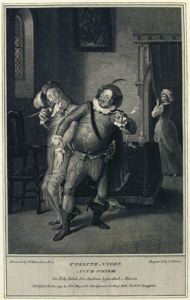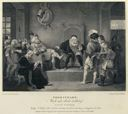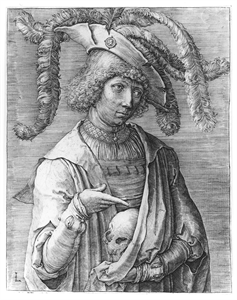
John Boydell
English, 1719–1804
Josiah Boydell (aka Joshua Boydell)
English, 1752–1817
James Fittler
English, 1758–1835
after William Hamilton
English, 1751–1801
From Boydell's Graphic Illustrations of the Dramatic Works of Shakespearefrom Boydells’ Graphic Illustrations of the Dramatic Works of Shakespeare
In 1786, a successful London publisher, alderman John Boydell, conceived of a gallery of art devoted to scenes from Shakespeare’s plays. Named for its founder, the Boydell Shakespeare Gallery was one of the first large-scale commercial endeavors intended to promote British literature and artists both in Great Britain as well as throughout the European continent. He commissioned over 167 paintings of scenes from Shakespeare’s plays and produced engravings based on these paintings. In creating the engravings, John Boydell partnered with his son, Josiah, whose name appears after his father’s in the list above. The third name is that of the engraver, and the fourth is that of the painter who created the original composition in oils. The role of the engraver was to transfer the painter’s composition onto plates for printing.
About this scene:
Crossdressing, tricksters, alcohol, and yellow stockings, anyone? That’s surefire comedy, as the chief instigator of raucousness, Sir Toby, proclaims here to his drinking buddy and victim Sir Andrew before they plot revenge on the severe steward, Malvolio. Their trick? Make him believe his employer, the countess Olivia, loves him.
She doesn’t—and won’t, because the main plot characters are in a love triangle fed by shipwrecked, grief-stricken Viola’s decision to dress like her drowned brother for safety. So she falls hopelessly in love with her new boss, the duke, who sends her to woo his unresponsive beloved Olivia, who promptly falls in love with this new “guy.”
Meanwhile, the subplot just wants to expose its dupes, Sir Andrew and Malvolio, who now acts on his secret desire to be count. Malvolio is publicly shamed and Sir Andrew’s trust shattered, though weddings ensue once the not-drowned twin brother lands in Illyria.
-Susan Willis, dramaturg, Alabama Shakespeare Festival, September 28, 2020
English, 1719–1804
Josiah Boydell (aka Joshua Boydell)
English, 1752–1817
James Fittler
English, 1758–1835
after William Hamilton
English, 1751–1801
Twelfth Night, Act 2, Scene 3
about 1804From Boydell's Graphic Illustrations of the Dramatic Works of Shakespearefrom Boydells’ Graphic Illustrations of the Dramatic Works of Shakespeare
Object Type:
Print
Dimensions:
10 5/16 x 6 7/16 in. (26 x 16 cm)
Medium and Support:
Engraving on paper
Accession Number:
2016.0008.0007
Credit Line:
Gift of Donald A. Winer, by exchange
In 1786, a successful London publisher, alderman John Boydell, conceived of a gallery of art devoted to scenes from Shakespeare’s plays. Named for its founder, the Boydell Shakespeare Gallery was one of the first large-scale commercial endeavors intended to promote British literature and artists both in Great Britain as well as throughout the European continent. He commissioned over 167 paintings of scenes from Shakespeare’s plays and produced engravings based on these paintings. In creating the engravings, John Boydell partnered with his son, Josiah, whose name appears after his father’s in the list above. The third name is that of the engraver, and the fourth is that of the painter who created the original composition in oils. The role of the engraver was to transfer the painter’s composition onto plates for printing.
About this scene:
Crossdressing, tricksters, alcohol, and yellow stockings, anyone? That’s surefire comedy, as the chief instigator of raucousness, Sir Toby, proclaims here to his drinking buddy and victim Sir Andrew before they plot revenge on the severe steward, Malvolio. Their trick? Make him believe his employer, the countess Olivia, loves him.
She doesn’t—and won’t, because the main plot characters are in a love triangle fed by shipwrecked, grief-stricken Viola’s decision to dress like her drowned brother for safety. So she falls hopelessly in love with her new boss, the duke, who sends her to woo his unresponsive beloved Olivia, who promptly falls in love with this new “guy.”
Meanwhile, the subplot just wants to expose its dupes, Sir Andrew and Malvolio, who now acts on his secret desire to be count. Malvolio is publicly shamed and Sir Andrew’s trust shattered, though weddings ensue once the not-drowned twin brother lands in Illyria.
-Susan Willis, dramaturg, Alabama Shakespeare Festival, September 28, 2020
Keywords
Click a term to view the records with the same keyword
Related Objects
Click a record to view

Tempest, Act 1, Scene 2
2016.0008.0001

Merry Wives of Windsor, Act 5, Scene 5
2016.0008.0002

Much Ado About Nothing, Act 4, Scene 2
2016.0008.0003

Midsummer-Night’s Dream, Act 2, Scene 1
2016.0008.0004

Merchant of Venice, Act 3, Scene 2
2016.0008.0005

Taming of the Shrew, Act 4, Scene 5
2016.0008.0006

Macbeth, Act 1, Scene 3
2016.0008.0008

Macbeth, Act 5, Scene 1
2016.0008.0009

King Richard II, Act 3, Scene 2
2016.0008.0010

King Henry IV, Part 1, Act 2, Scene 1
2016.0008.0011

King Henry V, Act 3, Scene 3
2016.0008.0012

King Henry VI, Part 1, Act 5, Scene 4
2016.0008.0013

King Richard III, Act 3, Scene 1
2016.0008.0014

Antony and Cleopatra, Act 4, Scene 4
2016.0008.0015

Romeo and Juliet, Act 3, Scene 5
2016.0009.0001

Hamlet, Act 3, Scene 4
2016.0009.0002

Hamlet, Act 4, Scene 7
2016.0009.0003
Portfolio List
Click a portfolio name to view all the objects in that portfolio
This object is a member of the following portfolios:
Your current search criteria is: Keyword is "KJ" and [Object]Century is "Nineteenth Century".

 by Artist (13)
by Artist (13)
